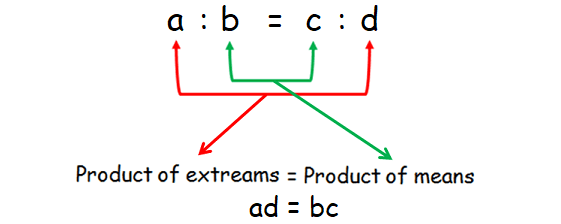CROSS PRODUCT RULE IN PROPORTION
Subscribe to our ▶️ YouTube channel 🔴 for the latest videos, updates, and tips.
Equality of two ratios is called proportion.
a : b = c : d
The two ratios above a : b and c : d are equal. So, they are said to be in proportion.
The proportion a : b = c : d is read "a is to b as c is to d". The numbers a and d are called the extremes of the proportion. The numbers b and c are called the means of the proportion.
Cross Product Rule
In a proportion, the product of the extremes is equal to the product of the means. This is called cross product rule.

If a/b = c/d, then ad = bc. The products ad and bc are called the cross products of the proportion a/b = c/d.
If three quantities a, b, c are in continuous proportion, then the middle term b is called the mean proportional between a and c, a is the first proportional and c is the third proportional.
Since three quantities a, b, c are in continuous proportion, we can write them as
a : b = b : c
Using cross product rule, we can solve for the mean proportion b.
product of means = product of extremes
b2 = ac
Taking square root on both sides,
b = √ac
Solved Problems
Problem 1 :
Check whether the four numbers 2.4, 3.2, 1.5 and 2 are in proportion.
Solution :
In the given numbers,
extremes = 2.4 and 2
means = 3.2 and 1.5
Product of extremes = 2.4 x 2 = 4.8
Product of means = 3.2 x 1.5 = 4.8
4.8 = 4.8
Product of extremes = Product of means
Since, the given numbers satisfy the cross product rule, they are in proportion.
Problem 2 :
Find the fourth proportion to 2/3, 3/7, 4.
Solution :
Let x be the fourth proportion.
Then, we have
2/3 : 3/7 = 4 : x
Using cross product rule,
product of extremes = product of means
(2/3)(x) = (3/7)(4)
2x/3 = 12/7
In the equation above, we have two different denominators 3 and 7.
Least common multiple of (3, 7) = 21.
Multiply both sides of the above equation by 21 to get rid of the denominators.
2x/3 = 12/7
21(2x/3) = 21(12/7)
7(2x) = 3(12)
14x = 36
Divide both sides by 14.
x = 36/14
x = 18/7
The fourth proportion is 18/7.
Problem 3 :
Find the third proportion to 2.4 and 9.6.
Solution :
Let x be the third proportion. Then, the numbers are
2.4, 9.6, x
Proportion :
2.4 : 9.6 = 9.6 : x
Using cross product rule,
product of extremes = product of means
2.4x = (9.6)(9.6)
2.4x = 92.16
Divide both sides by 2.4.
x = 38.4
The third proportion is 38.4.
Problem 4 :
Find the mean proportion between 1.25 and 1.8.
Solution :
Let x be the mean proportion. Then, the numbers are
1.25, x, 1.8
Proportion :
1.25 : x = x : 1.8
Using cross product rule,
product of means = product of extremes
(x)(x) = (1.25)(1.8)
x2 = 2.25
Take square root on both sides.
√x2 = √2.25
x = 1.5
The mean proportion is 1.5.
Example 5 :
Carter’s SUV requires 8 gallons of gasoline to travel 148 miles. How much gasoline, to the nearest gallon, will he need for a 888 mile trip?
Solution :
Let x be the no. of gallons of gasoline required for a 888 mile trip.
Form the proportion with the given information.
x gallons : 888 miles = 8 gallons : 148 miles
x : 888 = 8 : 148
Using cross product rule,
148x = (888)(8)
148x = 7104
Divide both sides by 148.
x = 48
So, 48 gallons of gasoline required for a 888 miles trip.
Example 6 :
If Andy drove 84 miles in 1 hour 45 minutes, how many miles can he drive in 5 hours?
Solution :
Let x be the no. of miles driven by Andy in 5 hours.
1 hours 45 minutes = 1⁴⁵⁄₆₀ hours
= 1¾ hours
= 7/4 hours
Form the proportion with the given information.
x miles : 5 hours = 84 miles : 1 hour 45 minutes
x miles : 5 hours = 84 miles : 7/4 hours
x : 5 = 84 : 7/4
Using cross product rule,
(7/4)x = (5)(84)
7x/4 = 420
Multiply both sides by 4.
7x = 1680
Divide both sides by 7.
x = 240
Andy can drive 240 miles in 5 hours.
Subscribe to our ▶️ YouTube channel 🔴 for the latest videos, updates, and tips.
Kindly mail your feedback to v4formath@gmail.com
We always appreciate your feedback.
About Us | Contact Us | Privacy Policy
©All rights reserved. onlinemath4all.com

Recent Articles
-
10 Hard SAT Math Questions (Part - 45)
Jan 19, 26 06:14 AM
10 Hard SAT Math Questions (Part - 45) -
10 Hard SAT Math Questions (Part - 44)
Jan 12, 26 06:35 AM
10 Hard SAT Math Questions (Part - 44) -
US Common Core K-12 Curricum Algebra Solving Simple Equations
Jan 07, 26 01:53 PM
US Common Core K-12 Curricum Algebra Solving Simple Equations
